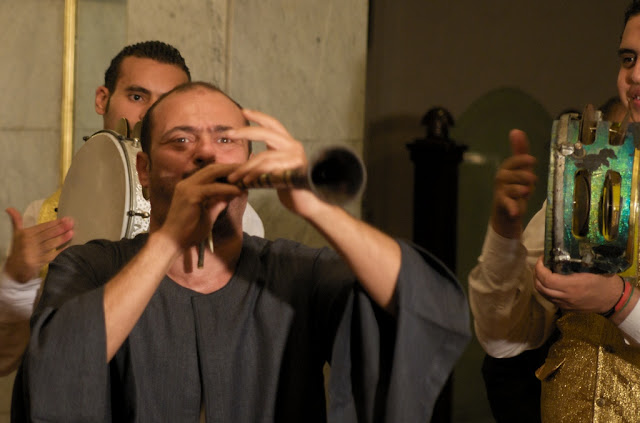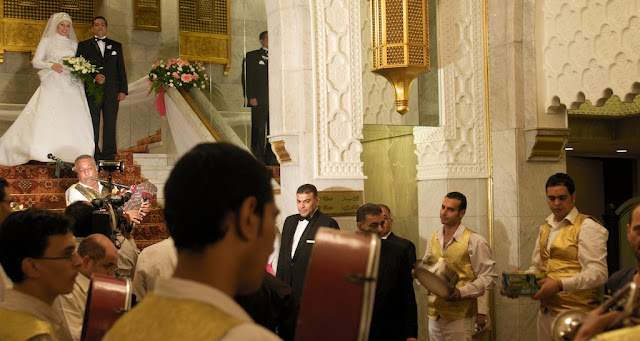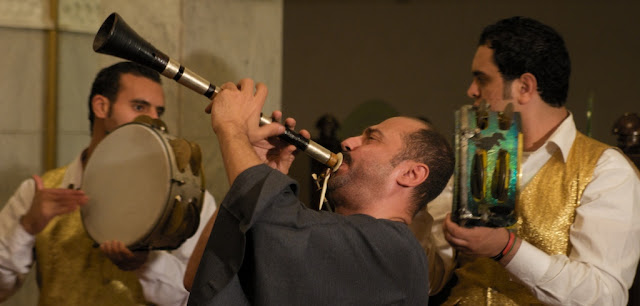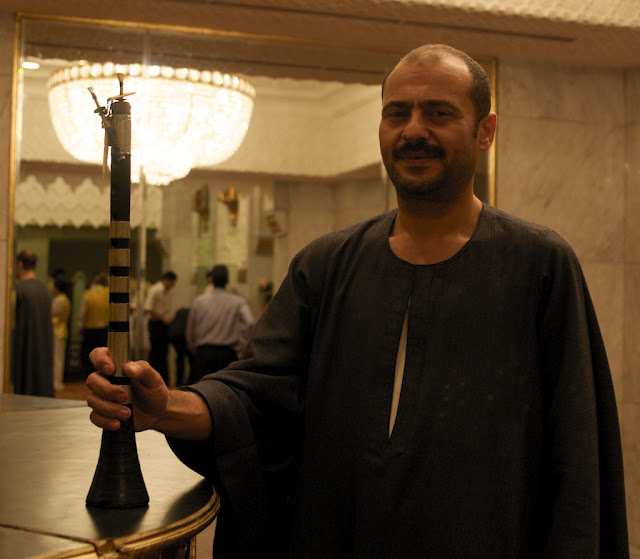One of the great traditional rituals we observed in Cairo is the zaffa (pronounced ZEH-fah), the wedding procession that is part of many Egyptian weddings. Scott Marcus, an Egyptian scholar at the University of California Santa Barbara, led us to the leader of one of Cairo’s busiest Zaffa troupes, Kamel Bahlol (or Kamel Mitwalli). What follows is a selection of Scott’s and Kamel’s comments on zaffa, and its signature instrument, the mizmar.
(Kamel Bahlol)
Banning Eyre: Scott, you have studied all sorts of folk music in Egypt. I want to talk about some of the traditions that use the folk oboe, the mizmar. Talk to us about that instrument generally, and then we’ll get into some of these wedding rituals.
Scott Marcus: Just for clarification, the accent is on the second syllable. [miz-MAHR] Mizmars are made from wood, usually wood from an apricot tree. There are many shapes that this instrument comes in, the mizmar. There are some that are quite short, maybe six or 8 inches long. There is a common one in the south, the sa`idi mizmar, which is about a foot, maybe 14 inches. And then the Eastern province one is really quite long, over 2 feet long. But they all have the exact same fingering, which is they have these holes on top, and then the thumb hole on the bottom, and then you blow into a double reed. The reed is a cylindrical piece of grass that has been flattened. We call this a double reed because, when you flatten the reed, like when you flatten a straw that we drink through, the grass reed has two walls that you blow through. The reed is placed on a metal piece called a staple. It's a cylindrical piece of metal that is put into the top end of the wooden mizmar. Then you put different fingers down to get different pitches. It's like a recorder.
Generally speaking, mizmars are all extremely loud. They are outdoor instruments. They are rather inappropriate for indoors, just because of the sheer level of volume. Historically, mizmar playing was a hereditary art, meaning you were a mizmar player only because your father or uncles were mizmar players. And you and your brothers would all be mizmar players. And this is still very much the case. Kamel, for example, his father is in this tradition, and probably his sons will be. Actually, I was with Kamel a number of times when he gave his cousins and his children lessons. So it is a family tradition. Generally, when you play a mizmar, you only play with other mizmars. So one ensemble is generally three of these melody instruments, and then generally two different percussion instruments. So you have basically a five-member ensemble. So if you play with one of the long ones, which is from the Eastern province, you are going to play with three long mizmars together. And if you are from southern Egypt, and play the sa`idi mizmar, you are going to play with three of those shorter ones. The sa`idi tradition is unique in that it also adds a singer. The sa`idi mizmar group is the only one that also includes a singer.

Something interesting happened in the '60s. People had the idea: why not bring a mizmar and put it into modern film music? Or into modern pop music. So they called this famous mizmar family from just north of Cairo, and they brought this fellow to Cairo. We actually know who this person is now, a member of the Hindi family. And they said, "Can you play with this music?" And he said, "But our mizmar is not tuned to play with the oud (`ud) or the flute, the nay." So they had to actually create a mizmar of a different size so that it could play with the traditional art music instruments. And so a whole new size of mizmar was created, and we have popular songs, and even art music songs that have the mizmar inserted. But this is not traditionally the case.
B.E.: Maybe you can help me clear this up, a question of name. You refer to Kamel as Kamel Mitwalli, but his business card says Kamel Bahol. Do you know why?
S.M.: You know, in Egypt, you are named with your own name, and then your father's name, and then your grandfather's name. So I believe his father was Mitwalli, and his grandfather I believe was named Kamel. So he is Kamel Mitwalli Kamel. But then, there's a name that goes back so that it was probably some name in the past, an ancestor, that people keep.
B.E.: Well, despite the confusion of names, there was no doubt that we had the right guy.
S.M.: I must say, I am just so thrilled that you worked with him.
B.E.: Well, thank you for steering us toward him. He was fantastic. And he had some interesting things to say about the mizmar. Here’s what he told us.
Kamel Bahlol: First of all, the origin of the mizmar, the one that we know today, it is from Turkey. But the people who actually came up with this instrument, the idea of a tube that you blow into and produce music were the Pharoahs. It is in the family of the nay and the kawala. But later on, the Turks developed the mizmar that we know today. We also manufacture the mizmar, but the word [wood???]we use is different, so there's a difference between the two instruments. But at the end of the day, we can say that this instrument was first thought of by the Pharoahs.
Actually, the mizmar I use now, I made it. I made it myself. And now, if I wanted to buy another mizmar, I would not buy it, I would make it myself. The one I have now I made 15 years ago. And I use it to this day. It has been through a lot. It has been smashed to pieces at one point, and I put it back together, and I still play with it.
B.E.: What about the double reed mouthpiece? That's something that's different from the nay and kawala. Did that come from the Turks?
K.B.: Well, what the Turks added to the mizmar gives us the instruments that we know now. What the Pharoahs made was the idea of a piece of wood with holes in it that produces sound, and then the Turks took it and added to it. But the mizmar is four pieces. There is the body and then there is the small metal conical staple that you tie the reed on to. The staple is placed into a small wooden adaptor at the top of the mizmar. And then there is the reed, which I call a risha. That is the thing that is responsible for producing the sound. So it's four parts to create the whole thing.

Now, the difference between the mizmar and the nay is that the mizmar is a more advanced version of the nay. The nay is more primitive, but from the same family, i.e. wind instruments. Now the kawala is very, very similar to the nay. The only difference between the two is the way you play it. It is basically also a length of reed (similar to a length of bamboo), but the way you play it, and the way the holes are arranged on the instrument is different. And that's why it produces a different sound.
B.E.: Kamel showed us his double reed as well. That’s another difference between mizmar and nay or kawala, of course. The nay and kawala are flutes, but the double reed makes the mizmar a type of oboe. But let's talk a little bit about the event itself, the zaffa.
S.M.: Okay. There are a lot of times in the lifecycle rituals where processions happen. So the most common is at weddings. Weddings are a multi-day occasion, and there are supposed to be a number of processions. You know, there's something called henna. Do you know what henna is?

B.E.: This is the dye used to paint the bride’s hands with artistic patterns. I've seen this done.
S.M.: Yes, it's a paste, right? So one of the things, one of the early moments in a wedding procession is you take the henna, and you process it around. In the village, you would process it around the village. In the city, you would process it around the neighborhood. So the word for procession is zaffa, and one of the processions that happens, one of the zaffas is the zaffa of henna, when you take the henna around. There is another one later on when you process the bride. And that's on the final night of the wedding, and you will process the bride, and the groom will come, and then you will process the bride and the groom, and so these happened, and they have happened, I would assume, for ages.
The zaffa that is generally presented in the films from the 30s, 40s, 50s, and 60s, were done by women ensembles. There would be a number of women, let's say eight or 10 or 12 or more, and all but maybe two or four of the women would be playing frame drums. So a frame drum is a circular drum of very little depth. And the women would be holding the drum in one hand and playing with the other hand, standing, and they would be singing, and then two or four of the women would be dancing along leading the procession. So this was the women's ensemble. You would hire this ensemble, and the bride would come, and then in the middle of the procession the groom would join. So they would be led as they are walking, by dancers, and on the sides, in a sense creating a column that is walking forward, the column would be defined by these women playing these frame drums and singing songs, with the percussion.

So what happened in the 70s, there was a man in Dumyat. Dumyat is a town on the coast, east of Alexandria, just right at the end of the Delta region, in the northeastern part, right on the Mediterranean, in the northeastern part of Egypt. And in Dumyat, he created a new type of zaffa that wasn't a women's ensemble, but a men's ensemble. So he brought all these young men together, and he gave them all frame drums of two types. One that had cymbals on them, so not only do you get the dumm and takk sounds, but you get a very bright metallic sound with it, because they have cymbals on the side. And you would get like 20 or 25 men, and they would create a very long U-formation.
B.E.: That’s just what we saw. Kamel pointed out that the idea of processing the bride and groom goes back to the Fatimids, the founders of Cairo.
S.M.: And inside the formation, there would be the bride and the groom, and the bride's mother and father, the groom's mother and father, perhaps aunts and uncles and friends, and they would process. And now it is 20, 25, or more percussion people, they would also singing. This was a new type of zaffa, and because it was from the city of Dumyat, it was called the Dumyati zaffa.
So this is what Kamel does. There are one or two or three melodic instruments in this, and specifically, it's the mizmar of the Eastern province, which is the longest of the mizmars, the one that's about 2 feet long. This could be the only melodic instrument, but in the Dumyati zaffa, they also decided, "Let's bring a couple of people who play brass instruments." And of course the people who play brass instruments in Egypt, all were people who learned in military bands. And then they’ll have all these men who play frame drums around them. They're all quite young men. So they are young guys, and they're playing this percussion as loud as they possibly can, singing at the top of their voices. It's quite an amazing thing.

So this became the rage. It went beyond Dumyat and became the rage in Cairo. In Cairo, especially at upper-class weddings, which occur at five-star hotels, will have the zaffa ensemble. And it's a good bit of expense, because you're hiring, as I say, 25 or so people. And what they do is they take the bride and groom and they process them around the halls of the five-star hotel at the end of which they bring them to the banquet hall. So as they get to the banquet hall, and the bride and groom enter the banquet hall, the zaffa band is finished. They immediately disappear. They very quickly leave the hotel, because they are not supposed to be there anymore. They’ve finished their gig. And if they are lucky, they will very quickly go to another date, where they have scheduled that they're going to do one zaffa at 9 PM, and do the next zaffa at 11 PM, or something like this. So if the band is quite famous, they might get lucky and do two or three zaffas a night. So this is the present-day zaffa. The Dumyati zaffa.
B.E.: That's great. You're describing exactly what we saw. We asked Kamel about the music he played that night. Here’s how that went.
Kamel Bahlol: What we just saw was an expression of joy and happiness, and it's the combination of classical music and also modern, more contemporary everyday music. And it's a combination that is not always 100% arranged, but we pick it up on the way. It is not improvised, obviously, but we pick up the vibe and go with it.
B.E.: You say it is part classical. What is the oldest origin of this tradition?
K.B.: Well, I can't say that the history goes way back. It's really back to the 50s and 60s or the 70s. Most of the music I get from the 70s. It's traditional stuff that people have been singing for that long. Some of the pieces I use are also from the 50s and 60s. There are various traditions from the old times. But you can't say they go way back like to the Pharaonic time. Also, it depends on the guests, my clients. Sometimes they request really traditional music, just the basic music. But if it's up to me, I usually put in some more modern stuff, and then some traditional stuff, and kind of make a special combination of the two.

B.E.: And what about tonight? What did we hear?
K.B.: First, we started with the bagpipe. It's basic and all weddings start with a little intro on the bagpipe. Then the chant that we began with. Then the songs. We used a part of a song by Umm Kulthum, “Fat al Mad,” and even though these things are not really traditionally used, I just kind of put them in there. These songs are not usually used at weddings. They are not part of the basic practice. But I like to mix in some of the more, not melancholic, but traditional, or classic music, and this also fulfills my artist's soul to use these parts and pieces. It has a bit of melancholy.
B.E.: Kamel, how many zaffas can you play in one night?
K.B.: Well, this season is a little different. So it's hard to be accurate. But it would be at least two a night. I can't say that I ever have a day off during this season before Ramadan. In other cities besides Cairo, someone might have to deal with six or seven zaffas a night. But here in the capital, it doesn't work that way. And in some of the provinces, the duration of the zaffa can be longer than what we've just seen. It might last an hour. But in the capital, they do it this way. Because you cannot really schedule all these zaffas so close together in this city, with the traffic you would never make it. I would hope that I could do that, 6 or 7 zaffas. Even 10. I could do that.
S.M.: It's interesting to me that there are actually three different groups of people. Because all the boys, they’re teenagers, or up to their 20s and 30s, not usually older, the ones who play the frame drums and sing. They are one category of people. And the mizmar player is a hereditary musician from a mizmar family, not like those kids. And then the trombone trumpet player, he's from the military. So he's a very different type of person. So it brings three different groups of people together into an ensemble.
B.E.: As you know, this is not a very easy thing to record. We were there in the hall following them around with a microphone, but it's pretty much impossible to get a good balance between those three groups, all moving targets. I think we may end up using some of your recordings on the air.
S.M.: Please. We brought them into a studio.

B.E.: Let's go to another type of mizmar music, from the South, the sa`idi style. We never made it to Luxor, or even to a sa`idi wedding in Cairo. But maybe you can take us there. Give us a description of that kind of event. What's special about it?
S.M.: One of the great things to do in Cairo is to go to a sa`idi wedding. You know, it's the idea that Cairo has grown because people from every part of the country have come to live in the big city, and so there are whole neighborhoods that are called folk neighborhoods--sha`bi, the word for "folk"--sha`bi neighborhoods. They all have apartment buildings that are just long lines of apartments, and they have a street in the middle, for the most part, they are not even paved streets, just dirt streets. And they are, I don't know, the width of maybe three or four cars between these long lines of apartment buildings. And in a given neighborhood, especially if there are sa`idi people there, it will be predominantly, it might be a predominantly sa`idi neighborhood.
When they have a wedding, they just block off one of these long lines of the street there, and they build a stage, a wooden stage. They are constructed so that the musicians are, I don't know, 6 feet above it all, so people all the way down this alley can see them very easily. And then they put the amplification system on the stage, and then they put speakers all the way down the way. So, for a block and a half, there might be all the speakers on either side of the apartment buildings. They will put lights, the kind of lights we think of as Christmas lights, with different colors. They'll put them in every imaginative way. They'll string them down the whole length so that when you walk in, it just feels incredibly festive. And then they rent chairs, and there will be chairs on either side, and they will rent little tables, just so that you give people little things to eat, maybe nuts or grapes. And you give them something to drink.
If you walk into a wedding that's already in progress, you will see many hundreds of people in this alley, and this might be 70 yards long, 80 yards long. And at the very end, you will see the band, up on top there. And traditionally, the main ensemble would be a mizmar ensemble, three mizmars and two percussionists and the singer. So this is the group.
One of the surprising things about amplification in Egypt at folk events is that they amplify and a very loud level. Very loud. Even to the point of being distorted. And that doesn't seem to be a problem. And then they add echo. So when someone says "Hello," you'll hear, "Hello, ello, lo, lo...". It just keeps echoing. It's quite a ridiculous level from a Western perspective, and it is a very distorted sound. But this is considered festive.
So the mizmar players are there. It's very interesting in that the mizmar players become the emcees of the event. So being up high like this, they can see all the way to the end, and when a new family comes into the wedding, they actually play very specific greeting songs, very, very short. These songs are called salaams. One of them has a very western sound. It goes.. SINGS A PHRASE. So they will play that three or four times, and everyone looks back to the back to see which family is being greeted. So the mizmar player always has to be on the lookout to see, and to make sure that they greet people. These events usually start about 10 o'clock at night and they might go on until three, four, five, six in the morning. And when people leave, they might again then perform salaams, as a way to send people off.
Sa`idi people, especially the menfolk, have all these ways that they dance at the sa`idi weddings. And one of the ways that they dance is they have these very heavy canes that the men will bring to the wedding. So they are maybe 4 feet tall or so, and very heavy. Wood or, I guess, bamboo. So they learn as children to sway this cane from side to side as they are doing a very graceful dance. And so, there are genres of music that when the mizmar starts doing that, everyone gets up from their chairs with their cane, and they start doing this dance. It's really quite remarkable.
B.E.: Sounds great. A reason to go back!








